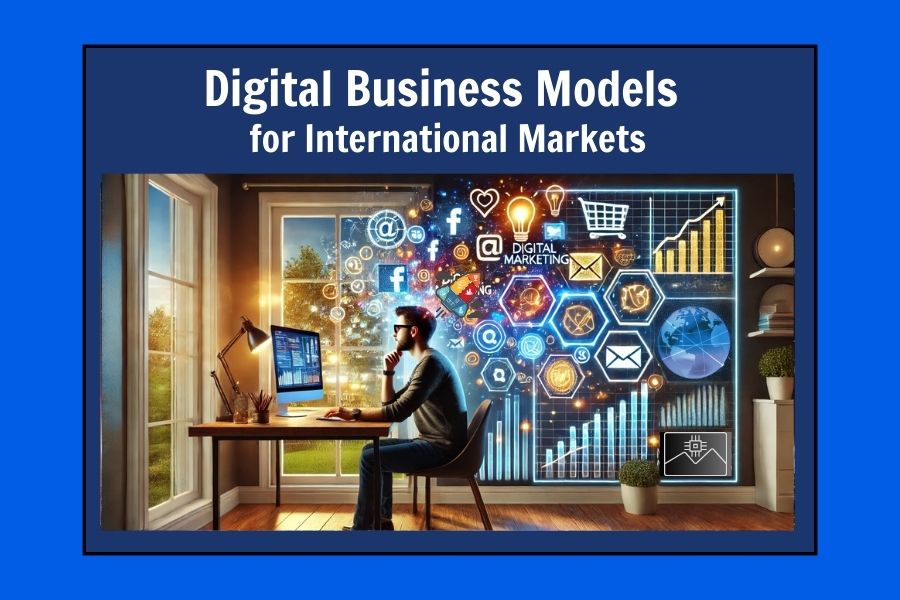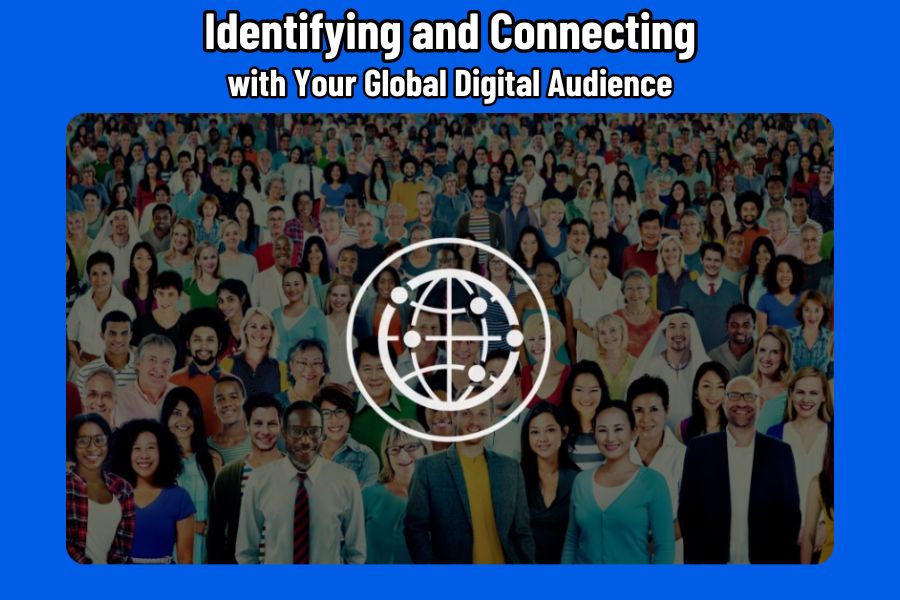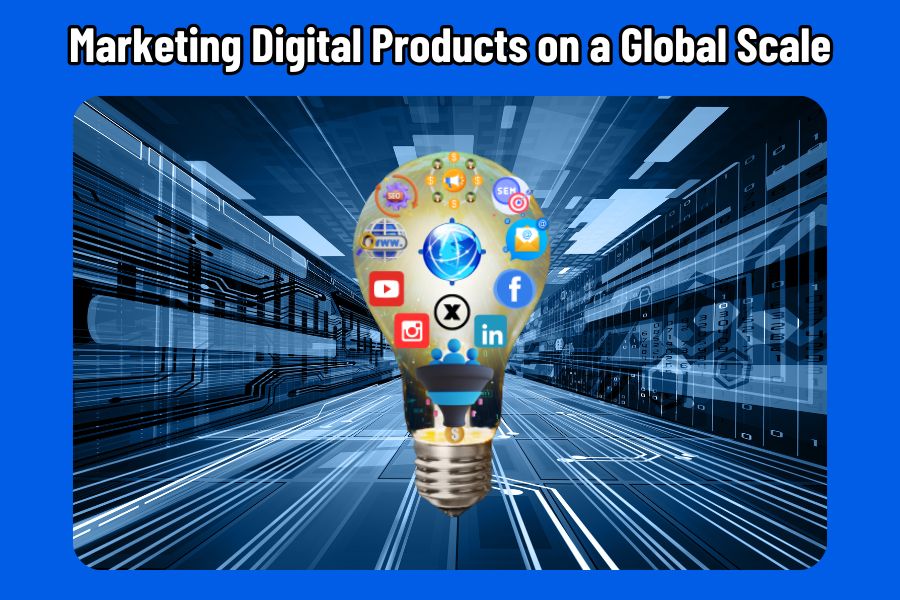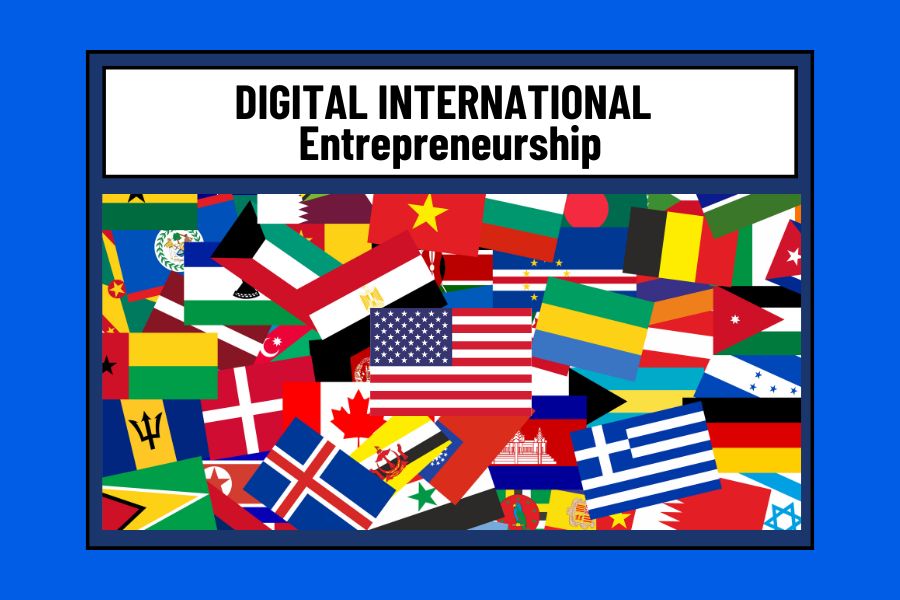Digital international entrepreneurship is your gateway to global success. Learn how to scale, market, and sell digital products worldwide in this expert guide!
Introduction
Expanding your digital business beyond borders is an exciting but can be a complex challenge. Whether you’re launching your first online venture or scaling an existing one, digital international entrepreneurship opens doors to global markets, endless growth opportunities, and a diverse customer base. But, without a clear roadmap, it’s easy to get lost in the complexities of selling digital products internationally.
This guide is designed to simplify that journey. We’ll walk you through essential considerations, from selecting the right digital business model, identifying your global target audience, international marketing, compliance, the latest tools, strategies, and best practices to ensure your business thrives on a worldwide scale. Whether you’re an ecommerce seller, content creator, SaaS provider, or digital service entrepreneur, this guide will help you make informed decisions and avoid costly mistakes.
Now, let’s start by understanding the digital landscape and why it’s crucial for international success.
Understanding the International Digital Landscape

Listen up digital entrepreneurs, before you take your digital business global, you need a solid grasp of the digital landscape and how it affects your expansion strategy. Selling digital products internationally isn’t just about translating a website or accepting different currencies—it’s about understanding the platforms, marketing tactics, data management, and legal requirements that shape global online commerce.
A lack of awareness in these areas can lead to poor customer experiences, compliance issues, and even lost revenue. To succeed in digital international entrepreneurship, you must build a strong foundation by mastering the key elements of today’s digital economy.
What is Digital International Entrepreneurship?
At its core, digital international entrepreneurship is about starting and scaling a business that operates entirely or primarily online, serving customers across multiple countries. Unlike traditional brick-and-mortar expansion, where international growth requires physical locations, digital businesses use technology to transcend geographical limitations.
Whether you’re selling digital products, SaaS solutions, online courses, or subscription services, your reach is no longer confined by borders—you have the power to access and engage with a worldwide audience. However, with this opportunity comes the responsibility of adapting to different market expectations, regulatory environments, and technological ecosystems.
Key Components of the Digital Landscape
To thrive in international markets, you must leverage the right tools and platforms to connect with your global audience. Here are the most critical components of the digital landscape that you need to master:
- Digital Platforms: Your business’s online presence is shaped by the platforms you use. This includes your website, e-commerce stores like Shopify and WooCommerce, social media channels for audience engagement, and mobile apps for enhanced customer experience.
- Digital Marketing Tools: Successful global businesses use a mix of SEO, PPC advertising, email campaigns, affiliate marketing, and influencer collaborations to drive traffic and conversions across international markets.
- Data Analytics and Management: Data is the lifeblood of any digital business. Using data collection tools, customer insights, and analytics platforms like Google Analytics or Hotjar helps refine strategies and improve user experiences.
- Infrastructure: Cloud computing solutions like AWS and cybersecurity measures ensure seamless operations, while IT support systems help maintain performance and security across different regions.
- Content Marketing Strategies: Educational and engaging content—blog posts, videos, infographics, e-books, and social media—plays a crucial role in attracting and nurturing global customers.
Important Factors to Consider
Beyond the foundational tools and platforms, there are several critical factors you must consider when expanding into international digital markets:
- Digital Business Models: Choose a model that aligns with your niche and product type—whether it’s a SaaS, online course, membership site, or e-commerce store.
- Target Audience: Research global market trends, analyze competitors, and build customer profiles based on cultural preferences, pain points, and buying behaviors.
- Digital Marketing Strategies: Localization is key. Leverage SEO for international markets, targeted social media campaigns, email marketing, paid ads, and community-building techniques to engage with different audiences.
- Technology: Stay ahead of emerging trends, integrate payment gateways that support multiple currencies, comply with international tax regulations, and ensure smooth digital product delivery.
- Data Analysis: Regularly track and analyze website traffic, social media performance, paid ad results, and sales metrics to optimize strategies for different regions.
- Legal and Compliance Considerations: From data privacy laws like GDPR to intellectual property protections, consumer rights, taxation, and cybersecurity, ensuring legal compliance is a must for international success.
Now that we’ve covered the essential components of international digital business, let’s explore each factor beginning with digital business models that work best for global markets.
Best Digital Business Models for International Markets

Choosing the right digital business solutions is crucial when expanding into international markets. Not all business models are suited for global scalability, and success depends on selecting a structure that aligns with your audience, product type, and delivery method. In international entrepreneurship, having a scalable model means you can operate efficiently in multiple markets without getting overwhelmed by logistical, technical, or regulatory challenges.
Identifying a Niche
Before selecting a business model, you must pinpoint a profitable niche that resonates with international customers. A niche isn’t just about choosing a broad category like “online courses” or “SaaS solutions”—it’s about honing in on a specific problem that your digital product solves for a well-defined audience.
Here’s how to refine your niche for global success:
Market Demand: Use tools like Google Trends and SEMrush to analyze search volume and customer interest across different regions.
Competitive Landscape: Study competitors in your industry to identify gaps and opportunities for differentiation.
Cultural Relevance: Ensure that your product or service aligns with cultural preferences, buying behaviors, and local regulations.
Scalability: Choose a niche that allows for easy expansion, avoiding models that are too reliant on localized operations.
By selecting a niche that addresses a high-demand problem with global relevance, you set the foundation for a digital business that can scale across borders with minimal friction.
Digital Product/Service Design
Once you’ve identified a niche, the next step is designing a digital product or service that can be accessed, purchased, and used seamlessly by an international audience. Your product must be globally adaptable—which means considering localization, pricing flexibility, and digital delivery.
Key considerations for international product/service design:
Language & Localization: Offer translations, subtitles, and culturally appropriate content to resonate with local markets.
Payment Accessibility: Integrate payment gateways that support multiple currencies and local banking systems.
Scalable Delivery System: Use cloud-based platforms to host, distribute, and automate digital product access.
Pricing Strategy: Adjust pricing based on economic conditions and customer purchasing power in different regions.
Whether you’re selling an ebook, a SaaS subscription, or an online coaching program, your business must be frictionless for global customers—making it easy for them to purchase and use your product without unnecessary barriers.
Digital Business Models
Choosing the right business model will define how your digital business generates revenue and scales internationally. Here are some of the most effective digital business solutions for global expansion:
E-commerce Marketplaces: Selling digital goods through platforms like Amazon, Shopify, and Etsy allows you to reach international buyers with built-in payment processing and logistics support.
Subscription Services: Recurring revenue models—such as SaaS, membership sites, and premium content subscriptions—offer predictable income and encourage long-term customer relationships.
Online Learning Platforms: Digital courses, coaching programs, and educational memberships on platforms like Teachable and Udemy provide scalable knowledge-sharing opportunities.
Digital Content Creation: Monetizing blogs, YouTube channels, or podcasting through advertising, sponsorships, and affiliate marketing can generate passive income from global audiences.
Cloud-Based Software (SaaS): Developing software solutions that serve an international customer base, such as project management tools, automation apps, or cybersecurity services.
Freelance Service Marketplaces: Selling services online through platforms like Fiverr, Upwork, or Toptal allows solopreneurs to work with clients worldwide.
App Development: Creating mobile or web applications that solve industry-specific problems or enhance business efficiency on a global scale.
Affiliate Marketing: Promoting other companies’ products through content marketing, social media, or email lists to earn commissions from global sales.
Selecting the right business model isn’t just about what you sell—it’s about how you package, price, and deliver value in a way that makes it accessible to customers worldwide.
Lets dive into the next factor—understanding your global target audience.
Identifying and Connecting with Your Global Digital Audience

Expanding internationally requires more than just having a great digital product—you need to know exactly who your customers are, where they are, and what drives their purchasing decisions. To succeed in digital international entrepreneurship, you must analyze market trends, study competitors, and tailor your messaging to different cultural and economic landscapes.
Market Research
Market research is the foundation of international success. You need to analyze industry trends in different regions to identify where demand for your product is growing and how customer preferences shift across borders. Demographic research helps you refine your targeting by considering factors like age, income levels, gender distribution, and professional backgrounds.
Psychographics take this a step further, offering insight into customer motivations, values, and lifestyle choices, which influence purchasing behavior. Language barriers are another critical factor. If potential customers can’t understand your content, you’ll struggle to convert them. That’s why localization—translating materials and adapting messaging to fit cultural contexts—is crucial for engagement.
Competitor Analysis
Studying successful businesses in your niche can reveal gaps in the market and areas where you can offer something unique. Competitor analysis helps you identify the major players in your target markets and understand their marketing strategies, pricing models, and customer engagement methods.
By evaluating how competitors position their products and attract customers, you gain insights into what works in specific regions and where opportunities exist for differentiation. If a competing brand lacks localized support or doesn’t cater to a specific customer need, you can step in and fill that gap.
Buyer Personas
Once you’ve gathered market data, you need to develop detailed buyer personas. A buyer persona isn’t just a general customer profile—it’s a representation of your ideal customer’s motivations, challenges, and online behaviors.
A freelancer looking for productivity software in Europe may have different expectations, spending habits, and preferred payment methods compared to a small business owner in Latin America.
Understanding these nuances allows you to personalize your messaging, pricing, and digital experience for each region, increasing your ability to connect with customers on a deeper level.
Online Research Tools
Leveraging research tools helps refine your understanding of customer behavior and market trends. Google Analytics provides insights into website traffic, showing where visitors come from and what content they engage with most.
Social media platforms like Facebook and LinkedIn offer audience demographic breakdowns, helping you gauge interest in specific regions.
Market research platforms such as Statista, Nielsen, and Similarweb provide valuable industry reports and trend data that can guide your expansion strategy.
By using these tools, you can validate your assumptions and make data-driven decisions about where and how to market your digital products.
Cultural Considerations
Culture plays a significant role in international buying behavior. A marketing campaign that resonates in one country may fall flat in another due to differences in communication styles, values, or even color symbolism in branding.
Localizing your messaging ensures that your product feels relevant and trustworthy to different audiences. Visual elements, such as website design, product images, and even font choices, should align with local preferences to create familiarity and connection.
Aligning promotions with regional holidays and events—such as Singles’ Day in China, Diwali in India, or Black Friday in North America—can further boost engagement and sales.
Focus on Pain Points and Needs
Ultimately, your success depends on how well your product solves a problem for international customers. Identifying pain points specific to different regions allows you to position your product as the ideal solution.
Entrepreneurs in emerging markets may prioritize affordability, while those in highly competitive economies may seek advanced features and automation.
By clearly communicating your product’s value in a way that resonates with each customer’s unique needs, you significantly increase your chances of converting leads into loyal buyers.
A deep understanding of your target audience leads to stronger engagement, higher conversion rates, and more sustainable international sales.
Now it’s time to explore the next factor—marketing your digital products on a global scale.
Global Marketing Strategies for Digital Products

You’ve identified your target audience, but now comes the challenge of reaching and converting them into paying customers. Without a well-executed digital product marketing strategy, even the most innovative digital products can struggle to gain traction in global markets.
To succeed in digital international entrepreneurship, you need a marketing plan tailored to different cultures, languages, and consumer behaviors. From content localization to paid advertising, this section explores the essential strategies for building brand awareness and driving international sales.
Content Localization
A one-size-fits-all approach to marketing won’t work when selling to diverse global audiences. Content localization is the process of adapting your website, marketing materials, and product descriptions to align with cultural preferences, languages, and buying behaviors in each target market.
Simply translating your content isn’t enough—you need to ensure your messaging resonates with local audiences. This means adjusting tone, imagery, and even product positioning to match regional expectations. For example, humor in one country may not translate well in another, and color choices in branding can carry different cultural meanings.
Additionally, region-specific case studies and testimonials can enhance trust and credibility, showing potential customers that your product is already helping others in their market. When done right, localization makes your brand feel native to international customers, increasing engagement and conversions.
Search Engine Optimization (SEO)
Optimizing your website for global search visibility is critical. Each market has its own search habits and preferred platforms—Google may dominate in most countries, but in China, Baidu is the go-to search engine, while Yandex is widely used in Russia. Adapting your SEO strategy for different markets ensures that your digital products are discoverable by local consumers.
Incorporate country-specific keywords and optimize your content for local search intent. If necessary, consider using country-specific domain extensions (.de for Germany, .fr for France) to improve visibility in regional search results.
A multilingual SEO approach, combined with localized backlinks and structured data optimization, ensures your content ranks well and attracts relevant traffic from different regions.
Social Media Marketing
Social media is one of the most powerful tools for digital product marketing on an international scale. However, different regions have varying platform preferences. While Facebook and Instagram are dominant in the U.S. and Europe, platforms like WeChat and Weibo are essential for reaching Chinese audiences, and VK is widely used in Russia.
Understanding where your target customers spend their time online allows you to focus your efforts on the right platforms. Developing region-specific campaigns ensures that your content is relevant and engaging. Partnering with local influencers can also accelerate brand awareness by leveraging their existing audience trust.
Influencer marketing isn’t just for consumer brands—it can be a powerful tool for digital product businesses as well.
Email Marketing
Email marketing remains one of the highest-converting channels, but sending the same message to all subscribers worldwide won’t yield the best results.
Personalization is key. By segmenting email lists based on geographic location, language, and interests, you can tailor your messaging to be more relevant to each audience.
For instance, an email campaign targeting European customers might focus on GDPR compliance and data security, while a campaign for Southeast Asian buyers might highlight mobile payment options.
Personalizing subject lines, offers, and content for different markets increases open rates and engagement, making email an effective tool for international expansion.
Paid Advertising
Running paid ads globally requires more than just setting up a Facebook or Google Ads campaign. To maximize your return on investment, you need a localized approach that considers language, cultural preferences, and regional buying behaviors.
Each advertising platform offers different targeting capabilities based on region. Google Ads and Facebook Ads provide global reach, but if you’re targeting Chinese consumers, you’ll need to explore Baidu Ads or WeChat advertising. Similarly, if you’re selling to customers in Japan, Yahoo! Japan Ads may be more effective than Google Ads.
Crafting ad copy that aligns with local consumer behavior ensures that your campaigns resonate with the right audience. Running A/B tests in different markets helps determine which messaging and creative elements perform best.
Affiliate Marketing
Affiliate marketing is a cost-effective way to expand your reach by leveraging the audience of influencers, bloggers, and content creators in different regions.
Partnering with affiliates who already have credibility in your target markets can drive sales while reducing the upfront cost of customer acquisition.
Choosing local affiliates who understand their audience’s preferences ensures that your digital product is marketed in an authentic and culturally relevant way.
Providing affiliates with localized content and promotional materials further enhances campaign effectiveness.
Community Building
Building an engaged community around your brand fosters trust and long-term customer loyalty.
Establishing online communities on platforms like Facebook Groups, LinkedIn, or even region-specific forums helps you connect with customers, answer their questions, and create a space for discussion.
Hosting webinars and live Q&A sessions tailored to different regions allows potential customers to interact with your brand in real-time.
All of these interactions help establish authority and create a sense of community that encourages brand advocacy and repeat purchases.
Customer Relationship Management (CRM)
Managing customer relationships on a global scale requires an efficient CRM system that tracks interactions, purchasing behavior, and feedback. A strong CRM strategy enables you to identify opportunities for personalization, whether through targeted promotions, follow-ups, or loyalty programs.
Providing localized customer support is also essential for maintaining trust and satisfaction. Offering multilingual support and region-specific contact options demonstrates your commitment to customer experience, helping you retain customers and build long-term loyalty.
Successfully marketing your digital products internationally requires a strategic approach that combines localization, platform-specific engagement, and data-driven optimization.
On to the next factor—let’s explore the technology and tools needed to support your international business expansion.
Technology for Selling Digital Products Globally

The backbone of digital international entrepreneurship is the digital technology that enables seamless transactions, secure data management, and smooth product delivery. Without the right tech infrastructure, scaling your business across borders can quickly become overwhelming.
From emerging technologies to payment gateways and compliance tools, having a well-integrated system ensures that you can efficiently sell, deliver, and support your digital products worldwide.
Emerging Technologies
The digital marketplace is constantly evolving, and staying ahead of emerging trends gives you a competitive edge in global markets.
Artificial intelligence (AI) is revolutionizing digital selling, offering personalized recommendations, automated chatbots, and predictive analytics to enhance customer experiences.
Augmented reality (AR) and virtual reality (VR) are transforming how digital products—especially in e-learning and SaaS—are demonstrated and consumed.
Voice search is another game-changer, as more users rely on smart assistants like Alexa and Google Assistant to find products and services online.
Leveraging these technologies helps streamline operations and improve customer engagement across international markets.
Payment Gateways
One of the biggest hurdles in selling globally is managing cross-border payments. Customers in different regions have preferred payment methods, and if you don’t offer them, you risk losing sales. A robust payment gateway allows you to accept payments in multiple currencies while ensuring security and compliance with local regulations.
To optimize your digital selling strategy, consider integrating platforms like PayPal, Stripe, and Wise for global transactions.
If you’re targeting specific regions, look into local solutions such as Alipay for China, PayU for Latin America, and Klarna for Europe.
Creating merchant accounts in multiple countries can further improve transaction efficiency, ensuring that customers can purchase without unnecessary friction.
Tax and Fee Compliance
Every country has different tax laws and compliance requirements, and failing to adhere to them can result in hefty penalties.
When selling digital products, you need to account for VAT, GST, and other international tax obligations. For example, the European Union requires businesses to collect and remit VAT on digital goods, while other countries have their own digital tax policies.
Automated tax solutions like Avalara and TaxJar simplify the process by calculating, filing, and remitting the appropriate taxes for each jurisdiction. These tools integrate with e-commerce platforms and payment gateways, ensuring compliance without the headache of manual calculations.
Staying ahead of tax regulations keeps your business legally sound and prevents costly disruptions.
Customer Support
Providing seamless customer service across time zones and languages is essential for global expansion. International customers expect quick and effective support, whether through live chat, email, or self-service knowledge bases. Implementing a multilingual support system ensures that language barriers don’t prevent potential buyers from making a purchase.
AI-driven chatbots can handle common inquiries, reducing response times and improving customer satisfaction. Platforms like Zendesk, Freshdesk, and Intercom offer scalable support solutions, enabling you to manage customer interactions efficiently.
Having dedicated regional support agents for high-volume markets also builds trust and improves customer retention.
Popular Digital Delivery Platforms
Once a customer makes a purchase, they expect instant access to their digital product. A reliable digital technology infrastructure for product delivery is crucial to maintaining customer satisfaction and reducing refund requests.
Whether you’re selling e-books, courses, software, or subscriptions, choosing the right platform ensures smooth and secure access to your products.
Here’s a breakdown of some of the best digital delivery platforms:
- Sellfy – Ideal for creators selling digital downloads like e-books, music, and videos, with built-in marketing tools.
- Payhip – Provides simple and secure file delivery with integrated VAT collection for international sellers.
- SendOwl – Offers automated product delivery, secure download links, and drip content options for subscription-based businesses.
- Podia – A great all-in-one platform for online courses, digital downloads, and memberships.
- Squarespace – Well-suited for digital entrepreneurs who want a professional website with built-in e-commerce features.
- DPD (Digital Product Delivery) – Specializes in secure digital product distribution with advanced licensing options.
- Gumroad – A popular choice for independent creators, offering flexible pricing models and direct-to-consumer sales.
- Thinkific – A dedicated online course platform with customizable learning experiences and built-in student engagement tools.
- Shopify – One of the most powerful e-commerce platforms for selling both physical and digital products, with extensive customization options.
- BigCommerce – Scalable for larger enterprises looking to sell digital products internationally.
- Systeme – A fully integrated international business solution that combines digital product delivery with email marketing, sales funnels, and automation. [LEARN MORE HERE]
Choosing the right platform depends on your product type, target audience, and preferred digital selling strategy. Ensuring smooth transactions and a secure delivery process will build trust and encourage repeat business.
With the right technology stack in place, your global digital business can operate efficiently and scale effortlessly.
Now, let’s look at the next critical factor—understanding key data analytics to measure performance and optimize international sales strategies.
Optimizing Data Analysis for Global Digital Growth

In digital international entrepreneurship, data is your most powerful asset. Making informed decisions based on real-time insights allows you to optimize marketing strategies, increase conversions, and maximize revenue. Without a solid digital product analysis strategy, you risk targeting the wrong audience, wasting ad spend, or missing key opportunities for growth in international markets.
Market Research
Before expanding into new markets, you need a data-driven understanding of your ideal customer base. Demographic analysis helps you identify which age groups, income levels, and occupations are most likely to purchase your digital products.
Understanding consumer behavior, including browsing habits and purchasing patterns, gives you insight into how people interact with your brand online. For example, some markets may prefer mobile-first experiences, while others rely heavily on desktop browsing.
Competitor analysis is another crucial aspect of market research. Studying competing businesses in your niche helps you identify pricing trends, product gaps, and successful marketing strategies. Monitoring customer reviews on competitor platforms can reveal unmet needs, allowing you to position your product as a better solution.
When done right, this research gives you a competitive advantage, helping you tailor your approach for each region.
Website Analytics
Your website is the foundation of your global business, and analyzing its performance is key to scaling effectively.
Traffic analysis helps you understand where visitors are coming from, how long they stay on your site, and which pages they engage with the most. A sudden spike in traffic from a specific country might indicate a new market opportunity, while a high bounce rate could signal issues with user experience or content relevance.
Conversion tracking goes a step further by showing how many visitors take desired actions, whether it’s signing up for a newsletter, downloading a lead magnet, or making a purchase. By identifying which landing pages perform best, you can optimize your conversion funnel and increase revenue.
Geolocation data further refines your targeting strategy by revealing which regions generate the most traffic and sales, allowing you to allocate marketing resources more effectively.
Social Media Analytics
Social media is a powerful driver of international sales, but to make the most of it, you need to analyze engagement data. Metrics such as likes, shares, comments, and follower growth provide insight into how well your content resonates with different audiences. If certain posts or campaigns perform exceptionally well in a specific region, you can replicate those strategies to drive further engagement.
Influencer marketing has become a major factor in digital product analysis, but not all partnerships yield the same results. Evaluating the effectiveness of influencer collaborations based on reach, engagement, and conversions ensures that you’re investing in the right voices for each market. Data-driven influencer selection helps maximize brand exposure while maintaining authenticity.
Paid Advertising Performance
Running paid ad campaigns without tracking their performance is a costly mistake. To ensure a strong return on investment, you need to monitor key advertising metrics such as click-through rates, conversion rates, and cost-per-acquisition (CPA). These indicators help you determine which ad creatives, copy, and audience segments perform best.
Audience targeting refinement is another critical factor in paid advertising success. Analyzing past campaign data allows you to adjust targeting criteria, ensuring that your ads reach the most relevant and high-converting audiences. If you notice that one demographic engages heavily but doesn’t convert, you may need to tweak your messaging or offer for that market.
Sales Data Analysis
Sales data offers valuable insights into customer behavior and long-term profitability. Understanding customer lifetime value (CLTV) helps you identify high-value customers who are most likely to make repeat purchases. By focusing retention efforts on these segments, you can increase overall revenue without constantly chasing new customers.
Tracking sales trends across different regions, product categories, and time periods helps you predict seasonal fluctuations and market demand. If certain regions see higher sales during specific months, you can adjust your marketing and inventory strategies accordingly. Identifying patterns in purchasing behavior ensures that your business remains agile and responsive to market needs.
A data-driven approach is essential for scaling your digital business globally. The insights gained from market research, website analytics, social media performance, and sales data will help you make smarter decisions and increase profitability.
Now that you understand how to track and interpret key data points,
Now, let’s look at the last factor for international success—legal and compliance considerations for selling digital products internationally.
Legal and Compliance Essentials for Global Digital Entrepreneurs

Expanding your digital business internationally presents incredible opportunities, but it also comes with legal and regulatory complexities that can’t be ignored. In international entrepreneurship, navigating global laws surrounding data privacy, intellectual property, consumer protection, and taxation is crucial for long-term success.
Without the right compliance strategy, your business could face hefty fines, legal disputes, or even restrictions in key markets. Ensuring your business is data compliant and legally protected is not just about avoiding risks—it’s about building trust with your customers and creating a secure, scalable business foundation.
Understanding Data Privacy
Data protection laws vary by country, but two of the most influential regulations are the General Data Protection Regulation (GDPR) in the European Union and the California Consumer Privacy Act (CCPA) in the U.S.
If you collect personal data from EU residents, GDPR requires you to obtain informed consent, provide clear data usage policies, and implement strong security measures.
Similarly, if you serve customers in California, CCPA mandates that consumers have the right to know what data is being collected, opt-out of data sharing, and request data deletion.
Beyond these two major regulations, many countries have their own privacy laws, which may require data localization, additional security measures, or specific disclosure policies.
If your business processes or transfers customer data across borders, using Standard Contractual Clauses (SCCs) or similar data transfer agreements ensures compliance with international data laws. Implementing these safeguards demonstrates that your business respects user privacy, builds customer confidence, and prevents costly legal penalties.
Intellectual Property
Your brand, content, and digital products are valuable assets that must be protected globally. Without proper intellectual property (IP) safeguards, your work could be copied, stolen, or misused in international markets.
Registering trademarks in key countries ensures that no other business can legally use your brand name, logo, or slogans.
Copyright protection extends to creative works like software, e-books, digital courses, and website content, preventing unauthorized use or reproduction.
If your business involves proprietary technology or innovative digital solutions, securing patents can provide exclusive rights to your inventions.
Taking these steps early protects your intellectual property, strengthens your brand, and prevents legal disputes down the road.
Consumer Protection
Consumer rights and e-commerce laws differ across countries, so it’s essential to ensure your business complies with fair trade practices.
Advertising, pricing, and product claims must align with local consumer protection laws to avoid misleading marketing or deceptive sales tactics.
E-commerce regulations dictate the legal requirements for selling digital products, including terms and conditions, refund policies, and dispute resolution mechanisms. And many countries require clear disclosure of pricing, subscription terms, and automatic renewal policies.
Ensuring compliance with these regulations not only protects your business from legal action but also builds trust and transparency with international customers.
Taxation and Fees
Cross-border taxation is one of the most complex aspects of international business. Each country has its own tax laws, and failure to comply can result in fines, business restrictions, or even criminal liability.
If you’re selling digital products in the European Union, you may need to register for Value Added Tax (VAT) and collect it at the point of sale.
Many countries, including Canada, Australia, and India, have similar tax requirements for digital businesses.
Corporate tax compliance is another critical factor—depending on where your business is registered and where you generate revenue, you may need to pay taxes in multiple jurisdictions.
Consulting with an international tax advisor can help you navigate these complexities, ensure proper tax filing, and minimize liabilities.
Licensing and Permits
Certain industries require specific licenses or permits to operate legally in international markets. For example, businesses in financial services, healthcare, or online education may need approval from regulatory authorities in certain regions.
Even if your business operates solely online, some countries mandate local business registration for foreign companies selling to their residents. Ensuring you have the proper licenses and registrations in place helps avoid operational disruptions and legal penalties.
Cybersecurity and Compliance Best Practices
Cyber threats are a growing concern for global digital businesses, making cybersecurity a top priority. Regular security audits help identify potential vulnerabilities, while transparent user consent policies ensure customers understand how their data is collected and used.
In the event of a data breach, having a response plan in place allows you to mitigate damage, notify affected customers, and comply with legal reporting requirements.
Appointing a Data Protection Officer (DPO) can help oversee compliance with privacy regulations and security policies. Additionally, adopting a Privacy by Design approach ensures that data protection is integrated into your business processes from the ground up.
International Legal Counsel
Given the complexity of international regulations, consulting with legal experts specializing in global digital business is highly recommended. An experienced international lawyer can help you navigate legal risks, draft compliance-friendly policies, and ensure that your business meets local regulatory standards.
Understanding and implementing the right legal and compliance measures is a critical step in growing a sustainable, data compliant digital business internationally. With the right protections in place, you will have peace of mind and can focus on scaling your operations confidently.
Now, let’s explore how you can move forward with a practical roadmap for launching and optimizing your global digital business.
Closing
Moving Forward
Digital international entrepreneurship is about more than just selling products worldwide—it’s about creating a seamless, data-driven, and customer-centric experience that transcends geographical barriers.
Now is the time to apply what you’ve learned, refine your approach, and take actionable steps toward building a thriving international digital business. Whether you’re just starting or looking to optimize your global operations, the key is to stay adaptable, stay informed by continuously analyzing market trends, and leverage technology to your advantage.
Surprising Fact
Did you know that by 2027, global digital commerce is projected to exceed $8.1 trillion, with cross-border sales accounting for a significant portion of this growth? This explosive expansion presents an unprecedented opportunity for digital entrepreneurs to tap into emerging markets and build international brands. The only question is—are you ready to take your digital business to the next level?
With so many possibilities ahead, you likely have more questions about expanding internationally. Let’s dive into the most common FAQs to help you navigate the world of global digital entrepreneurship with confidence.
FAQs: International Entrepreneurship
Expanding your business globally comes with plenty of questions. Whether you’re just getting started or refining your international strategy, understanding the challenges, opportunities, and legal considerations of digital international entrepreneurship is essential. Below, we answer some of the most common questions to help you navigate the world of cross-border digital business with confidence.
How to Expand My Digital Business Globally on a Tight Budget?
Answer Digital International Entrepreneurship:
Expanding internationally doesn’t have to mean spending thousands on localization, tax compliance, or logistics. One of the most cost-effective ways to scale your business globally is by promoting affiliate products instead of selling your own. By becoming an affiliate marketer, you can monetize your content without worrying about collecting EU VAT, handling tax compliance in different countries, or setting up payment processing for international customers.
Affiliate marketing works by embedding affiliate links within your blog, website, or social media content. When a visitor clicks on an affiliate link, they are redirected to the seller’s website, and the responsibility for collecting international taxes and fees falls on the product vendor—not you. This allows you to generate income without dealing with complex global tax regulations. As your affiliate income grows, you can then reinvest in additional revenue streams such as selling your own digital products—while maintaining a profitable international presence.
To maximize success, ensure that the affiliate products you promote are high-quality, relevant to your niche, and available for international purchase. Promoting globally accessible digital products—such as online courses, SaaS tools, ebooks, or stock assets—ensures that your audience, regardless of location, can make a purchase. Additionally, transparency is key. Your website policies should clearly disclose your use of affiliate links, and for legal protection, consult an expert to ensure your policies comply with international regulations.
When Are Digital Sellers Required to Collect EU VAT?
Answer Digital International Entrepreneurship:
If you’re selling digital products to consumers in the European Union (EU), you may be required to collect Value Added Tax (VAT)—regardless of where your business is located. The EU VAT rules apply to all businesses that meet the following three conditions:
- You sell digital products (e.g., software, online courses, ebooks, stock media, SaaS subscriptions).
- You accept sales from EU consumers (B2C).
- Your total annual revenue from EU sales exceeds €10,000.
Unlike traditional tax laws, the location of your business does not matter. Since 2015, EU VAT has been based on the buyer’s location—not the seller’s. This means that even if your digital store is based in the U.S., Canada, or anywhere else, you must comply with VAT regulations if you sell to European consumers and surpass the revenue threshold.
The complexity of EU VAT comes from the fact that each EU country has its own VAT rate. You are required to charge the VAT rate of the customer’s country, not a fixed EU-wide percentage. This makes compliance challenging, as there is no universal VAT rate across all EU member states.
There is an exception for business-to-business (B2B) sales. If you sell digital products to a registered EU business, you are not required to charge VAT under the reverse charge mechanism. However, you must validate and store the business’s VAT number in your records to prove the transaction qualifies as B2B.
If your company is required to collect EU VAT, here’s what you need to do to stay compliant:
- Register for a VAT number in any of the EU’s 28 member states.
- Collect the correct VAT rate based on the customer’s country for B2C transactions.
- Provide valid VAT receipts that include your VAT number and breakdown of VAT charges.
- Store two pieces of evidence confirming the customer’s location (e.g., billing address and IP address) for 10 years.
- Submit quarterly VAT returns detailing how much VAT was collected and remit payments accordingly.
Manually handling VAT for multiple EU countries is nearly impossible for small businesses. Instead, automated tax compliance tools simplify the process. Quaderno, for example, automatically calculates VAT, generates tax-compliant invoices, and helps you file returns. Other solutions include TaxJar, Avalara, and Stripe Tax, which integrate with popular e-commerce platforms like WooCommerce, Shopify, and Systeme.io.
By using the right tax automation software, you can streamline compliance, avoid penalties, and continue scaling your digital business in EU markets without unnecessary hassle.
Why Are International Sales So Important to a Digital Entrepreneur?
Answer Digital International Entrepreneurship:
International sales allow digital entrepreneurs to break free from geographical limitations and reach a much larger customer base. Instead of relying on a single market, selling globally diversifies revenue streams, reduces dependency on local economic conditions, and opens up opportunities for business growth.
With the right digital tools, marketing strategies, and localization efforts, expanding internationally can significantly increase your business’s profitability and resilience.
What Is the International Entrepreneur Rule?
Answer Digital International Entrepreneurship:
The International Entrepreneur Rule (IER) is a U.S. immigration policy designed to allow foreign entrepreneurs to build and scale their startups in the United States. It provides a temporary visa-like status for entrepreneurs who have secured funding and can demonstrate their startup’s potential to create jobs and contribute to the economy.
While this rule specifically applies to U.S.-based entrepreneurship, many countries have similar programs to attract global business talent. Digital entrepreneurs seeking international residency options should explore startup visa programs in countries like Canada, the UK, and Portugal, which encourage foreign business owners to establish and grow their ventures.
What Key Challenges Do Digital Entrepreneurs Face Internationally?
Answer Digital International Entrepreneurship:
Selling digital products worldwide comes with its own set of challenges. Language barriers, cultural differences, and localized consumer behavior can impact marketing effectiveness. Payment processing and financial regulations vary across countries, requiring entrepreneurs to integrate multiple payment gateways. Data privacy laws, like GDPR in Europe and CCPA in California, impose strict compliance requirements on how businesses handle customer data.
Additionally, digital entrepreneurs must navigate global tax policies, legal registrations, and cybersecurity concerns to ensure smooth operations in multiple markets. While these challenges may seem complex, they can be managed effectively with thorough research, strategic planning, and the right digital tools.
What Are the 5 Ps of International Marketing?
Answer Digital International Entrepreneurship:
The 5 Ps of international marketing—Product, Price, Promotion, Place, and People—are essential principles for scaling a business globally:
- Product – Your digital product must be tailored to different markets, considering cultural preferences and localization needs.
- Price – Pricing strategies should reflect local purchasing power, competitive benchmarks, and tax implications.
- Promotion – Marketing efforts, including SEO, paid ads, and influencer collaborations, must be adjusted for regional trends and consumer behaviors.
- Place – Understanding where and how customers prefer to buy (e.g., e-commerce platforms, mobile apps, social commerce) ensures accessibility.
- People – Focusing on customer service, brand trust, and local engagement helps establish a strong international presence.
Mastering these elements ensures that your digital business remains competitive and appealing across different global markets.
Why Is Digital Entrepreneurship Popular Nowadays Globally?
Answer Digital International Entrepreneurship:
The rise of digital entrepreneurship is driven by rapid advancements in technology, the accessibility of online business tools, and the increasing demand for remote services. Unlike traditional businesses, digital entrepreneurs don’t need physical storefronts, making it easier and more cost-effective to scale worldwide. E-commerce, SaaS, online education, and digital content creation offer limitless growth potential with minimal overhead costs.
Additionally, the growing gig economy and preference for remote work have made digital entrepreneurship more attractive to individuals looking for flexibility, independence, and financial freedom. As global internet penetration increases, opportunities for digital international entrepreneurship continue to expand, allowing businesses to reach new customers and markets with ease.
How to Find Lawyers That Specialize in Digital International Entrepreneurship?
Answer Digital International Entrepreneurship:
Navigating international business laws requires specialized legal expertise. To find a lawyer with experience in digital international entrepreneurship, consider using online legal directories such as Avvo, Martindale-Hubbell, or UpCounsel. Many international law firms offer services specifically for digital entrepreneurs, including assistance with business registration, tax compliance, intellectual property protection, and data privacy regulations.
Networking with other global entrepreneurs and joining digital business communities can also provide valuable recommendations for trusted legal professionals. If you’re expanding into a specific country, working with a local business attorney ensures that you fully understand the regulations and compliance requirements in that jurisdiction.
Attention Digital Entrepreneurs
Scaling Your Digital Business with the Best All-In-One Marketing Platform
Expanding globally doesn’t have to be overwhelming. With the right tools, you can streamline your business processes, manage marketing campaigns, automate sales funnels, and handle payments with ease. Systeme is an all-in-one marketing platform designed for digital entrepreneurs looking to scale their businesses internationally. From building high-converting sales pages to managing email marketing and affiliate programs, Systeme simplifies every aspect of global digital selling in a single dashboard.
Ready to take your digital business to new international markets? Try Systeme today and experience a hassle-free way to grow and automate your online business worldwide. It’s 100% FREE [JOIN HERE]





